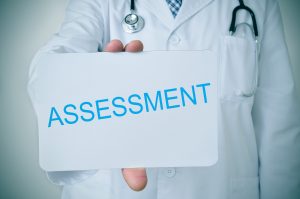The patient presenting in a confused state requires careful assessment. Seek expert advice where there is a significant deterioration in the patient’s clinical presentation.
Physical and Neurological Examination
Perform physical examination looking for physical causes of discomfort. Repeat neurological examination looking for new impairments or deterioration in previous neurological deficits.
Assessment Tools
Use brief objective assessment tools which measure vital  signs, cognition, arousal levels and physical wellbeing. Compare the patient’s performance with previously obtained baseline measurements where possible. Examples of assessment tools include:
signs, cognition, arousal levels and physical wellbeing. Compare the patient’s performance with previously obtained baseline measurements where possible. Examples of assessment tools include:
- The ‘Early Warning Scores’ (EWS): this tool assesses six cardinal vital signs (i.e. respiratory rate, SaO2, temperature, blood pressure, heart rate, AVPU response – “Alert, Voice, Pain, Unresponsive”) to help exclude sepsis as a cause of deterioration in cognitive functioning.
- Glasgow Coma Scale to measure level of consciousness.
- MoCA – Montreal Cognitive Assessment.
- ACE III – Addenbrookes Cognitive Examination.
Signs of Raised Intracranial Pressure
It is important to be vigilant for signs of raised intracranial pressure which include:
- Headache
- Vomiting
- Increased blood pressure or widened pulse pressure (increase in the difference between the systolic and diastolic pressure readings).
- Bradycardia
- Changes in respiratory rate
- Oculomotor impairment or pupillary dilation
- Papilloedema (optic disc swelling)
- Reduced consciousness
Medication Review
It is important to re-assess the need for all prescribed medications, especially those recently introduced. Options for dose reduction and/or non-sedative alternatives should be explored. Benzodiazepines should be withdrawn if possible.
Eliminate Secondary Complications of Brain Injury